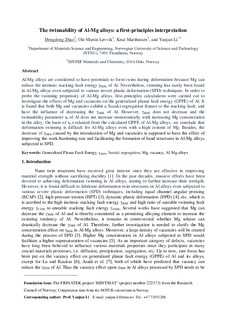| dc.contributor.author | Zhao, Dongdong | |
| dc.contributor.author | Løvvik, Ole Martin | |
| dc.contributor.author | Marthinsen, Knut | |
| dc.contributor.author | Li, Yanjun | |
| dc.date.accessioned | 2017-10-25T08:59:40Z | |
| dc.date.available | 2017-10-25T08:59:40Z | |
| dc.date.created | 2017-07-17T10:27:21Z | |
| dc.date.issued | 2017 | |
| dc.identifier.citation | Transactions of Nonferrous Metals Society of China. 2017, 27 (6), 1313-1318. | nb_NO |
| dc.identifier.issn | 1003-6326 | |
| dc.identifier.uri | http://hdl.handle.net/11250/2462041 | |
| dc.description.abstract | Al–Mg alloys are considered to have potentials to form twins during deformation because Mg can reduce the intrinsic stacking fault energy γISFE of Al. Nevertheless, twinning has rarely been found in Al–Mg alloys even subjected to various severe plastic deformation (SPD) techniques. In order to probe the twinning propensity of Al–Mg alloys, first-principles calculations were carried out to investigate the effects of Mg and vacancies on the generalized planar fault energy (GPFE) of Al. It is found that both Mg and vacancies exhibit a Suzuki segregation feature to the stacking fault, and have the influence of decreasing the γISFE of Al. However, γISFE does not decrease and the twinnability parameter τa of Al does not increase monotonically with increasing Mg concentration in the alloy. On the basis of τa evaluated from the calculated GPFE of Al–Mg alloys, we conclude that deformation twinning is difficult for Al–Mg alloys even with a high content of Mg. Besides, the decrease of γISFE caused by the introduction of Mg and vacancies is supposed to have the effect of improving the work-hardening rate and facilitating the formation of band structures in Al–Mg alloys subjected to SPD. | nb_NO |
| dc.language.iso | eng | nb_NO |
| dc.publisher | Elsevier | nb_NO |
| dc.rights | Attribution-NonCommercial-NoDerivatives 4.0 Internasjonal | * |
| dc.rights.uri | http://creativecommons.org/licenses/by-nc-nd/4.0/deed.no | * |
| dc.title | Twinnability of Al–Mg alloys: A first-principles interpretation | nb_NO |
| dc.type | Journal article | nb_NO |
| dc.type | Peer reviewed | nb_NO |
| dc.description.version | acceptedVersion | nb_NO |
| dc.source.pagenumber | 1313-1318 | nb_NO |
| dc.source.volume | 27 | nb_NO |
| dc.source.journal | Transactions of Nonferrous Metals Society of China | nb_NO |
| dc.source.issue | 6 | nb_NO |
| dc.identifier.doi | 10.1016/S1003-6326(17)60152-3 | |
| dc.identifier.cristin | 1482400 | |
| dc.relation.project | Norges forskningsråd: 222173 | nb_NO |
| dc.relation.project | Notur/NorStore: NN9347K | nb_NO |
| dc.description.localcode | © 2017. This is the authors’ accepted and refereed manuscript to the article. LOCKED until 11.7.2019 due to copyright restrictions. This manuscript version is made available under the CC-BY-NC-ND 4.0 license http://creativecommons.org/licenses/by-nc-nd/4.0/ | nb_NO |
| cristin.unitcode | 194,66,35,0 | |
| cristin.unitname | Institutt for materialteknologi | |
| cristin.ispublished | true | |
| cristin.fulltext | preprint | |
| cristin.fulltext | postprint | |
| cristin.qualitycode | 1 | |

